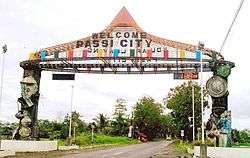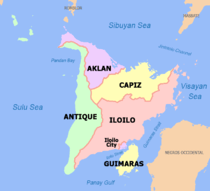Passi, Iloilo
| Passi | ||
|---|---|---|
| City | ||
| Lungsod ng Passi | ||
|
"Welcome to Passi City" welcome sign along IBRD Expressway Iloilo City - Passi City section | ||
| ||
| Motto: The Sweet City at the Heart of Panay | ||
 Map of Iloilo showing the location of Passi | ||
.svg.png) Passi Location within the Philippines | ||
| Coordinates: 11°06′N 122°38′E / 11.100°N 122.633°ECoordinates: 11°06′N 122°38′E / 11.100°N 122.633°E | ||
| Country |
| |
| Region | Western Visayas (Region VI) | |
| Province | Iloilo | |
| Legislative district | 4th district of Iloilo | |
| Founded | 1766 | |
| Cityhood | March 14, 1998 | |
| Barangays | 51 | |
| Government[1] | ||
| • Mayor | Jesry T. Palmares | |
| Area[2] | ||
| • Total | 251.39 km2 (97.06 sq mi) | |
| Population (2010)[3] | ||
| • Total | 79,663 | |
| • Density | 320/km2 (820/sq mi) | |
| Demonym(s) | Passinhon | |
| Time zone | PHT (UTC+8) | |
| ZIP Code | 5037 | |
| Dialing code | 33 | |
| Income class | 4th Class[2] | |
| Website |
www | |
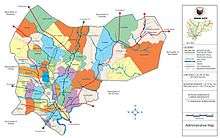
Passi, officially City of Passi (Karay-a: Syudad kang Passi/Syudad ka Passi; Hiligaynon: Dakbanwa sang Passi; Filipino: Lungsod ng Passi) and often referred to as Passi City, is a third class city in the province of Iloilo in the Philippines. According to the 2010 census, it has a population of 79,663 people.[3] It has a total land area of 25,139 hectares (62,120 acres),[2] making up 5.39% of the provincial land area of Iloilo. Its relatively flat land stretches alongside the Jalaur and Lamunan rivers. Mountainous areas are found along the northern part of the city.
Passi is a rice, pineapple, and sugar-rich area and the only component city and the largest in the Province of Iloilo in terms of land area, population and income. It is popularly known with its slogan "The Sweet City at The heart of Panay" due to its vast pineapple plantations and annual output in fruit production.
Geography
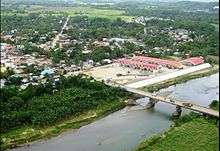

The City of Passi is centrally located on the island of Panay and can be reached by Iloilo - Capiz highway (IBRD Expressway). It is 50 kilometres (31 mi) from Iloilo City and 66 kilometres (41 mi) from Roxas City.
The City of Passi is located south of Dumarao, southeast of Bingawan, east of Calinog, northeast of Dueñas, north of San Enrique, and southwest of San Rafael.
Climate
Passi like most of the Iloilo’s towns, belong to the third type climate region which has no pronounced maximum rain period and no distinct dry and wet season while it is not within typhoon belt but it has its own share of typhoons that visits the province of Iloilo occasionally.
Rivers and Water Supply
The city is traversed by 5 major rivers namely (1) Jalaur River (2) Lamunan River (3) Hin-ayan River (4) Asisig River and (5) Maliao River. It also has creeks and tributaries which can be tapped for irrigation purposes.
Potable water resources can also be tapped from natural springs or from ground water which is bountiful in the area especially in the barangays of Imbang Grande, Bayan, Sarapan, Sablogon, and Jaguimitan.
As of this time, the barangays of Agdayao and Quinagaringan Gde. has level III type water supply and the Barangays of Jaguimitan and Bagacay has level II type of water system. The water needs of the Poblacion is served by the City of Passi which get its supply from the six deep wells and two springs at Brgy. Sablogon, Bacuranan and Man-it.
Political Subdivisions
Passi City is politically subdivided into 51 barangays (38 rural barangays, 11 urban barangays, and 2 city proper barangays), which are grouped into four geographical districts.
Barangays Poblacion Ilawod and Ilaya are the highly urbanized barangays of the city because the two compose the city proper area of Passi. Majority of the downtown area is occupied by Poblacion Ilawod. Dorillo Street divides the whole city proper area into two barangays; the western portion occupied by Poblacion Ilaya, and the eastern part occupied by Poblacion Ilawod. Barangay Poblacion Ilawod was the political center of Passi when it was a municipality; however, the new city hall and the government center were transferred to Brgy. Sablogon when Passi was proclaimed as a city in 1998.
The City of Passi belongs to the 4th District of Iloilo.
Listed below are the respective population of each barangay as of 2010.[2][3]
- Agdahon - 1,466
- Agdayao - 1,284
- Aglalana - 3,335
- Agtabo - 1,721
- Agtambo - 1,174
- Alimono - 2,738
- Arac - 1,429
- Ayuyan - 634
- Bacuranan - 1,101
- Bagacay - 863
- Batu - 1,328
- Bayan - 687
- Bitaogan - 2,051
- Buenavista - 530
- Buyo - 761
- Cabunga - 1,246
- Cadilang - 929
- Cairojan - 1,210
- Dalicanan - 2,039
- Gemat-y - 1,055
- Gemumua-Agahon - 3,711
- Gegacjac - 526
- Gines Viejo - 1,945
- Imbang Grande - 2,227
- Jaguimitan - 2,653
- Libo-o - 684
- Maasin - 806
- Magdungao - 2,248
- Malag-it Grande - 701
- Malag-it Pequeño - 276
- Mambiranan Grande - 576
- Mambiranan Pequeño - 580
- Man-it - 4,295
- Mantulang - 515
- Mulapula - 1,458
- Nueva Union - 2,265
- Pangi - 767
- Pagaypay - 567
- Poblacion Ilawod - 6,559
- Poblacion Ilaya - 3,473
- Punong - 374
- Quinagaringan Grande - 1,187
- Quinagaringan Pequeño - 1,011
- Sablogon - 1,849
- Salngan - 2,826
- Santo Tomas - 2,061
- Sarapan - 1,048
- Tagubong - 2,048
- Talongonan - 1,440
- Tubod - 862
- Tuburan - 544
History

Although its young distinction as a city, Passi is considered to be one of the oldest Spanish settlements in Iloilo. It was organized as a pueblo in 1766 with Don Martin Saligumba as its first leader. But the place has actually been settled by three Malayan brothers named Dig-on, Tokiab and Umawang long before the arrival of the Spaniards. Their first formal community was located on the site presently occupied by the Roman Catholic Church.
According to popular legend, Spanish conquistadors stumbled on a small hut by the river’s bank where an old woman was fond winnowing pounded rice. One of them asked her, “¿Cómo se llama este lugar?” not knowing the native language of course. Much to the old woman’s surprise and perhaps excitement, she replied without much ado, “Ah, pasi,” which means some of the unhusked rice on her basket. She must have thought that they were eager to know what was in the basket and what she was doing, because she could not understand their language. From that time on, the Spanish begun to call the place Pasi at first until it later evolved into Passi. Such legends about name origins are common throughout towns and cities in the Philippines, the core plot being a Spaniard asking the non-Spanish speaking natives what the name of the place is and the latter responding in what would end up eventually as the name of the place.

It is said that the first Spanish settlement was established in the area in 1766, marking the onset of Spanish colonial rule. In the traditional story, Spanish explorers anchored in Ansig, a place located at the mouth of Lamunan River. The founding of the present poblacion of Passi was attributed to Don Martin Saligumba. His notable title “Don” indicated his leadership and power over the group.
In 1957, the sitio of Agtabo in the barrio of Salngan was converted into a barrio.[4] In the same year the barrio of Santa Rosa was renamed Santo Tomas.[5]
Passi then became progressive and had experience tremendous development over the period. Because of its strategic location, Passi became a center for trade and commerce bringing more investment opportunities to the municipality. Its high income, high population growth, and a big area of land has finally bring into the limelight and recognized as the first component city in the Island of Panay. After a hard-earned endeavor, its conversion as a city was made through the signing of R.A. 8469 on the 30th day of January, 1998 by the Former President of the Philippines, Pres. Fidel V. Ramos.
Historical Notes About Passi
- Passi was the pre-war capital of Iloilo Province in January 1942 to April 16, 1942 until the landing of Japanese Occupation Force.
- Passi was made the quartermaster depot of United States Air Forces in Europe (USAFE) for the food of the army that resisted in Bataan through Capiz.
- All her building in the central school became the seat of the provincial government offices including the Agricultural and Industrial Bank and the Philippine National Bank before the Japanese landing in Panay.
- Passi has the first warehouse of the Compania General de Tabacos de Filipinas in Central Panay which lately became the Roman Catholic Church and also the warehouse of the USAFE for foodstuff for Corregidor and Bataan.
- Ibajay Cave and mountain northeast of the poblacion was the seat of the Municipal Resistance Government under Mayor Filoteo Palmares and Municipal Treasurer Pedro Oro during the war years.
- Passi Central Elementary School (now Passi I Central School) had the first clean and beautiful ground in the province before the war.
- One of the first regional high schools established in Iloilo was in Passi soon after liberation and one of the first to have acquired the widest site for high school of 12 hectares. Its athletic field cut from a hill and bulldozed by Mayor Palmares, leveled, improved, and beautified in time for the most lavished Unit Athletic Meet ever held in the interior in 1949-1959.
- The record of Passi in holding the First Provincial Athletic Meet in the interior before the war and in sustaining all the athletic delegations from different towns in Iloilo most abundantly and freely of which some meat uneaten were only given to them gratis et amore and some heads of cattle (surplus) sold for athletic fund ̶ still unbroken up to this day ̶ a feat that has never been or will ever be equaled in the history of athletic meets of Iloilo.
- In matters of bestowing the old Filipino traditional customs of being hospitable to individual visitor, visiting teams and districts, Passi’s record is yet unsurpassed because sumptuous foods and drinks offered by truckloads and caritos flow like water without reservation of any kind.
- Passi has the biggest cattle ranch in Panay before the war because of her wide grazing land.
- Passi therefore was the biggest supplier of meat for the army during the war and also the biggest supplier of rice and corn for sustenance of the guerilla forces and the Provincial Guards of the Civil Resistance Movement of Free Panay and Romblon Gov. Tomas Confesor.
- Passi, through her community school program, community education and improvement is beginning to regain her lost prestige and reputation as the cleanest and most beautiful town in the interior of Iloilo or elsewhere.
- During Spanish regime, Passi was very popular for being the home of wealthy families outside Iloilo City.
- Passi became the first component city of Iloilo in 1998.

Demographics
| Population census of Passi | ||
|---|---|---|
| Year | Pop. | ±% p.a. |
| 1990 | 57,701 | — |
| 1995 | 59,539 | +0.59% |
| 2000 | 69,601 | +3.40% |
| 2007 | 76,045 | +1.23% |
| 2010 | 79,663 | +1.71% |
| Source: National Statistics Office[3][6] | ||
The natives of this city are called Passinhons, with most people speaking Kinaray-a. together with other surrounding towns.
According to recent census, Passi City had a population of 82,869. An influx of Cebuano and Tagalog-speaking businessmen and investors in the years increased their numbers and were added. The Passinhon people are predominantly Roman Catholic, as the religion comprises almost 95 percent of its population.
Economy
The physical resources of Passi consists of relatively good soil types along rolling hills and narrow valley plains with substantial surface and ground water, with no distinct dry and wet season which is suitable for a wide range of agricultural products like rice, sugarcane, and pineapple. When the sugar industry experience a slump due to falling sugar prices and quotas in the world market, farmers diversified into other agricultural products like corn, pineapple, mongo, root crops, and other farm- based products. The City has investment potentials for Agri-Industrial developments.
Passi is a 4th class component city with this year’s annual income of P300,860,719-General Income, P26,732,922-Special Educational Fund, P37,287,853-Trust Fund, with a total current operating income of P364,881,424 .

Passi City has played an important role in reaching its peak of progress. Centrally situated in the province, Passi City is locally important as the District Agri-Industrial Center of Iloilo with three sugar centrals. It is rich with agriculture resources that have long formed the backbone of its economy and agricultural diversification produces crops such as rice, corn, vegetables, coconut, sugarcane and pineapple. Passi City has been an important pineapple producer for years, it has long been known for other industries including fruit processing, wallboard production, metalworking production and cut-flower propagation. Its locally produced pineapple wine, jam and fruit preserves have already established captured market with its exposure to various local trade fairs and exhibits such as the annual Fiesta in the City celebration during May; TUMANDOK in September; and WOW Philippines: the Best of the Region.
Passi, a component city (R.A. No. 8469 by Pres. Fidel Valdez Ramos last January 30, 1998.) is bounded on the north by San Enrique; Dumarao, Capiz on the south; east by Calinog; and Lemery on the west. Predominantly a mountainous area, it is politically divided into 51 barangays. It is about 50 kilometers from the city of Iloilo, 70 kilometers from the city of Roxas and has an area of 25,139 hectares or 251.39 km2---the largest in the province.
Industrial development is one of the priority concerns of the local unit being one of the five Agro-Industrial district in the Province and the site for People's Industrial Enterprise (PIE's) District Agro-Industrial Center (PAIC) in the 4th District. The PIE's / DAIC's provide intermediate processing of indigenous raw materials produced in their respective influence area for final processing at the DAIC. They also manufacture finished goods cooperative advantage for such manufacturing activities would prove viable.
Famous attractions in the city are the wide pineapple plantations, the cock farms, the Baroque Church of Saint William the Hermit, the old Muscovado Chimney, the Chameleon Butterfly Garden, the Amorotic caves of Brgy. Magdungao, the breath-taking highway view with good sunset and the old Railway Bridge which needs some preservation and attention spanning the Jalaur River.
Recently, CCTV cameras were installed along city proper roads, national highways, public market, large establishments, hospital, bus terminal, some political subdivision boundaries, and other strategic areas due to sudden increase in crimes this 2010 to 2011.
Banking
Passi City being the center of trade and business outside Iloilo City, several banking institutions are presently serving in the city and the surrounding municipalities.
| Name | Location |
|---|---|
| Philippine National Bank | F. Palmares St., beside St. William The Hermit Parish Church |
| Land Bank of the Philippines | Simeon Aguilar St., in front of Gaisano Capital Passi |
| BDO UniBank | R&T Bldg., Simeon Aguilar St., beside Gaisano Capital Passi |
| One Network Bank | Corner San Juan-Salvacion Streets |
| Robinson's Bank | Gaisano Capital Passi (Commonwealth Drive Wing) |
| Producers Bank | F. Palmares St. (old national highway going to Calinog) |
| Imperial Bank | Perfecto St. (at the back of Passi City Social Hall) |
| Card Bank | San Juan St. |
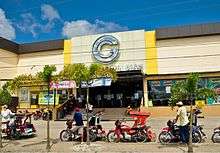
Shopping
Being the component city of Iloilo Province, Passi serves as the major shopping destination outside the province's capital city. Several department stores and shopping centers are located in the downtown, such as Gaisano Capital Passi, so far the only shopping mall in Passi. But despite the presence of this shopping center, their numbers still continues to grow as Passi is getting bigger as an urban area.
During the very huge success of the grand opening of Gaisano Capital in Passi City last October 2010, many businessmen were enticed to establish new businesses in the city. There were rumors that SM and Robinson's will also have their malls here at Passi quite soon, however, a recent city ordinance explained that a newly opened mall or any large establishment are given the chance to operate for five years prior to its grand opening before another counterpart establishments operate their businesses in the city.
CityMall (Philippines) Commercial Centers Inc. recently announced that the city will have its own CityMall. The site is now leased and is under construction at the lot of the present Passi City Bus Terminal located at the Iloilo-Capiz New Route (F. Palmares St.) corner Alberto Perlas St., Passi City, Iloilo.
Power and Energy
Power distribution is facilitated by Iloilo Electric Cooperative II (ILECO II), to Passi City and neighboring towns such as Dueñas, San Enrique, and Calinog.
Communications
The presence of advanced telecommunications infrastructure not only makes the Philippines readily accessible through the Internet, but also allows investors to ignore limitations imposed by the inadequacy of physical infrastructure. Passi City’s economy benefits from the presence of key players in the telecommunications industry, which provide the necessary “info-structure” for commerce.
Available communication services in Passi are: telephone services including domestic and international direct dial, mobile communications, internet, cable television, post offices and other services.
There are four (4) telephone service providers in Passi providing landline connections to almost several households, offices and establishments. These are: Philippine Long Distance Telephone Company, Isla Communications Co., Inc. (ISLACOM), Bureau of Telecommunications (BUTEL), and Panay Telephone Corpooration (PANTELCO).
Cellular telephone facilities are also provided by three (3) cellular companies namely Smart Communications, Globe Telecom and Sun Cellular.
Radio and Television Stations
Passi City is also the provider of local cable (now in digital format to support HDTV standards) TV service to most home, offering the same quality of the leading TV satellite at an affordable price. Milkyway Cablevision Services, Inc. (MCSI) offers 74 national and international television channels, plus one local channel (Milkyway Community Channel) showing local programming and talk shows. Talking Point is one of the major programs of this channel where a particular person or organization of an institution is interviewed regarding the particular matters or topics relevant to the City of Passi.
89.1 Radyo Natin Passi (now defunct) was so far the only local radio station that was broadcasting in Passi.
Here are the television and radio stations available in Passi City on-air:
Telecommunications
- PANTELCO: Panay Telephone Corporation
- ISLACOM: Isla Communications Co., Inc.
- BUTEL: Bureau of Telecommunications
- EXTELCOM (defunct)
Print Media
- Passinhon Times: The official publication of the City of Passi.
Culture
Language
Kinaray-a is the most spoken language, although there are sometimes mixtures of Hiligaynon in the conversation. Filipino and English are also widely used, most especially in business talks.
Kinaray-a is the most dominant language spoken in Passi City. English is used as the language of business and education. In addition, other local dialects such as Hiligaynon is also spoken. Some Spanish words are used accompanying the Kinaray-a conversation, which is very evident among the elderly and some wealthy families and also the elder members of the micro-community of sugar-plantations related families.
Festivals and Tourism
Some festivals in the province of Iloilo have either come back from near extinction or have evolved. And because of this, efforts have been undertaken by the community to breathe life into these cultural presentations that form part of a larger program of the tourism initiatives of the province to fully claim the title as the festival capital of the region, and to promote Ilonggo culture through the revival and preservation of traditional music and dances.
- Pintados de Pasi
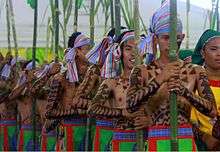
The Pintados de Pasi Festival, in Passi City, central of Iloilo province, is one way of celebrating the cityhood of Passi in March 1998. This festival is perhaps one of the best known and established festivals of the Visayan region that have evolved through the years. It has played a big part in the lives of most Passinhons. It is the most popular spectator cultural event and the most popular for the community that has a large following. Theatrical-like street dancing performances are a celebrated part of the Pintados festivity that is characterized by heavy and aggressive body movements. Here, performers adorned in traditional body tattoo with elaborate geometrical designs in their body, including their arms, legs and torso dramatizes stories in which the towns’ ancestral beings laid down every feature of the area, especially, their way of life.
Characterized by heavy and aggressive body movements, the dances seem to have developed independent of any external influences, as in the combat dances, folk plays, ritual actions, or character types. Historical or cultural sources are essential materials in sustaining a festival such as theirs. The festivity changed over the years, though its cultural presentation remained popular up to this day, and has resurrected and form part in a celebration that reflected function and transition. It also represented a major change in style and subject matter.
Panay Island has a very rich cultural heritage. Dubbed as the cradle of civilization, its glorious past is diverse. Its fertile folklore has become the envy of other cultures that many have wanted to disprove them but to no avail.

The Island pride itself of the epic of Hinilawod and the story of ten Bornean datus. Its imposing landscape is a good mind of narratives that were passed on from generation to generation and have been preserved in the hearts of its people. The first inhabitants of the Island called it Aninipay, after the name of the plant that was then abundant in the area. When the Malayans came, they named it Madia-as, which was the name of the highest peak in the Island.
The name Panay was given only after the Spaniards came to the Island. When Miguel Lopez de Legaspi settled in Cebu, he was faced with a problem of food storage. Hidden sent his men to scour the surrounding Island for food and one of the boats reached Madia-as. Having found plenty of food in the place, the crew returned to Cebu and reported the news to Legaspi who exclaimed in thanksgiving “Pan hay in este isla" (“There is food on this island!”). The first two words eventually identified the island.
But unknown to many, the first batch of Spaniards that reached the island gave a different name to it. They called it “Isla de Pintados” after seeing tattooed men whom they called pintados or “painted people.” The art tattooing was practiced all throughout the island. The chronicler Miguel de Loarca, in his account in Historia Pre-Hispanica de Filipinas Sobre la Isla de Panay, described the pintado practice, thus: “The mean tattoo intire bodies with beautiful figures using small pieces of iron dipped in ink. This ink incorporate itself into the blood and the marks are indelible.”
Culturally, the inhabitants of Panay used tattoos to exhibit their record in battle. The more tattoo marks a man had on his body, the higher his status as a warrior. The elegance of the pintado practice has raised tattooing into the level of art. They do then with such order, symmetry, and coordination that they elicit admiration from those who see them.
While the men put tattoo all over their body, it was a rule in the old Panay society that women only wear tattoos on one side of their arms.
According to one account, while a group of Spaniards who had settled in Calinog went downstream of the Jalaur River and anchored in a place called Ansig, they saw a tattooed woman who was winnowing pounded palay. One of them asked her what the name of the place is. The woman, who did not understand Spanish, thought that the man was asking what she was doing and replied “naga-pangpasi” which means peaking out unhusked rice from pounded palay. From then on, the Spaniards called the place “Pasi” which later involved into “Passi”. As the Spaniards begun to Christianize the inhabitants of Panay, the friars believed the tattooing was a pagan practice and forced the natives to abandon the art, thus resulting to the disappearance of the pintado culture.
However, the practice did not escape the eyes of historians who recorded it with respect and veneration that this form of art deserve. For many, it was a practice that ought not only to be preserved but also to be revived in some other ways to highlight the fact that during the pre-Spanish era, an advanced civilization of artistic people had already flourished in this part of the archipelago. It is in this context that Passi, one of the earliest Malayan settlement in the island, embarks on this project to showcase and revive one of Panay’s rich cultural legacies from its ancestors.
ImageTourism, through this cultural celebration brings thousands of local and international visitors interested to know the city’s rich history, considerable scenic beauty, and a number tourism attraction. The Passinhon 2000 Incorporated devotes their efforts of promoting the festival in the local and national scene. These efforts focus on the cultural festivity—at least in the early promotional stage, is the best way to keep it alive, and a variety of innovative efforts are underway to do just that.
Aside from having its own festival, Passi City also joins as a competing tribe at the Kasadyahan during Iloilo Dinagyang Festival. Last 2005, Pintados de Pasi was hailed as champion during the said event. The said tribe represented the Iloilo Province during the 2005 Aliwan Festival in Manila. Again, Passi was hailed as the overall champion. After garnering those awards, the city announced that they will no longer join as a competing tribe during Dinagyang and that they will become a fully independent festival. The year, 2008 marks the 10th Foundation Anniversary.
Pinta Lawas (body painting) as well as carabao (water buffalo) painting contests are being practiced followed by Karosa Parada (carriage parade that is drawn by a painted carabao) Binibining Pintados, a boat and bicycle racing events, Sinadya sa Suba (fun in the river) and a tribal dancing competition.

- Christmas in the City
Christmas in the City is held every middle of December until the first Sunday of January in the next year. Aside from the opening of lights, and grand fireworks display at Plaza Paloma, the opening of food stalls also go underway, that is why this celebration in more popularly called as "Food Festival" instead. The entire streets surrounding the plaza (F. Palmares St., A. Panes St., Saligumba St., M. Palmares St.) are closed since the kiosks and tables and chairs are placed to accommodate visitors and tourists.
- Kapistahan
Passi City celebrates the feast of its patron saint, San Guillermo de Ermita (St. William the Hermit) on the 10th of February along with the coronation of a fiesta queen.
St. William The Hermit Parish Church

This is considered a militaristic church in that it was planned as a ‘fortress church’ and the proof of this can be seen in the massive buttresses which support the front and back walls of the church. The church was built to replace churches that had been destroyed by an earthquake in 1612 and subsequent churches that had been destroyed by fires.
In 1856 Friar Pedro Ceberio restored the church that had fallen into disrepair and what we see today is the result of his work.
As is usual in churches of this vintage that can immediately discern that it was built, once again, by the Augustinians since their seal appears in the archway over one of the side entrances. It is said that the historical record is vague on the topic of entrances that indicates that historians are not certain as to where the actual main entrance was placed by the original builders. It appears that it may well have been this doorway on the southeast corner of the church at the entrance of the ‘Garden of Saints’.
All was well with the church through the Revolution and the Philippines American War but in 1932 the roof was blown away by a typhoon.
The church is surrounded by a ‘Garden of the Saints’ which contains 25 to 30 statues of Saints that have been placed in the garden by parishioners over the years.
Perhaps the most striking feature of the entire church is the sanctuary, which when is light up is both dramatically breathtaking and simply beautiful.
Inside the very tall belfry of the church are the three bells, two of which are massive ones and the other one is a small one. To ring the large one, they need to step on the chain that is attached to the bell’s clapper to make it hit the sound rim. The harder it is stepped on it the louder would the sound be. The two other bells are rung manually. They have to hold the two clappers together and hit them to the sound rim to make them work. This makes the bell ringer so close to the bells when ringing them.
Discovery and Foundation
The discovery of Passi, at the same time its foundation as a mission parish by the Spanish explorers for Panay Island occurred in 1584. It was placed under the patronage of St. William whose feast had since then been celebrated every February 10. In 1593, Padre Juan Villamayor, an Augustinian friar, became its first resident priest. The first mission church was made out of light materials and located near the riverbank of Jalaur River. In 1600 the church was transferred from the old site to its present location. The foundation and the walls were made of stones, slabs and lime. The parishioners were made to carry the needed materials every time they went to the church. The construction was finished during the time of Padre Pedro Ceberio when Salvador “Badong” Panes Perfecto was the Captain of the town.
- Schism and Abaca
Around 1821 during the time of Padre Apolinario Villanueva, Schism ensued between him as Parish Priest and the Spanish Populace of the town. He transferred the seat of the Parish Church to Abaca where he constructed a chapel. When Padre Martin succeeded him, the seat of the parish church was returned to Passi.
- Aglipayon Revolution
With the concurring Filipino Revolution against the Spanish government, there was a clamor of the Filipino Clergy for reforms. Padre Rafael Murillo, the Parish Priest then was a good follower and supporter of the Aglipay. He was elevated to the rank of an Aglipayan Bishop not long brought with him his family. To support his family, he demanded tributes from the people. The Passinhons under Captain Badong Perfecto strongly objected and Padre Joaquin was removed not long after.

Spanish Era to Post-War Years
Padre Lorenzo Diaz, a Catholic Augustinian Priest administered the Parish. The year 1891 saw the last Spanish Augustinian Parish Priest of Passi in Padre Bravo.
- Reverend Father Amado Panes Perfecto
In 1893, after three centuries of Christianization, Passi was able to produce its first priest, Padre Amado Panes Perfecto. He studied in the University of Salamanca in Spain and graduated a Doctor of Canon Law, which at that time was a rare privilege. He was appointed the first Filipino Priest of Passi. He constructed the most beautiful convent in the Diocese furnished with carved furniture and imported chinaware and utensils. One of his remaining masterpieces is the “Flores de Mayo Salve” which has become part of the tradition of the town.
- World War II
World War II was conflagration for the Passinhons. Fire gluttered all the Spanish built houses of the town. The guerillas burned all the buildings leaving the town empty for the occupying Japanese. Nothing was left of the wooden structure of both church and convent but the stones. The church was made the garrison of the Japanese forces and later the headquarters of the Residence Civil Government. Filipino troops under the Philippine Commonwealth Army and Philippine Constabulary were liberated in Passi and help the local guerrilla groups by attacking Japanese troops and ended in World War II.
- Lady Caycay earthquake
The 1948 Lady Caycay earthquake occurred on January 25, 1948 at 1:46 AM UTC+08:00 in Panay Island, Philippines. The bell tower did not survive the harshness of the earthquake. The tall tower was wrecked; making the entire bells fell down to the ground. No damage was found except for the other massive bell, which had a very slight crack on it.
The Church from Then and Now
- Reconstruction
The reconstruction of the church took a gradual development. The wood and nipa roofing of the church was constructed during the time of Padre Parreñas. Wooden posts were placed at the Eastern side of the church as temporary area to place the bells, since the bell tower was damaged during the 1948 earthquake. When Padre Buenaflor took over, he had the roof changed into galvanized iron. The improvement of the altar which was transferred by Padre Parreñas to the main entrance of the church was done during the time of Padre Castaño. The present church with its steel trusses, washed walls, benches, and a new but permanent belfry, together with the old parish convent already demolished, the Assumption School and the former Social Hall, were all constructed as projects of Msgr. Eligio Villavert, the 81st Parish Priest of Passi.
- Final Restoration and Renovation
It was 1997 when the Parish of St. William was graced with another Passinhon Priest. Msgr. Felipe Dativo Palomo, P.C., fully supported by the Parish Councils and the Passinhon Parishioners both local and abroad decided to venture into ambitious but necessary projects. In the year 2000, the completion and the blessing of the Jubilee Hall, the largest and tallest parish convent in the whole Diocese was witnessed.
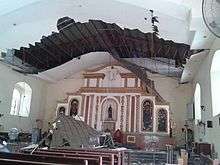
After the completion, behind the church, the attention of the parishioners and Msgr. Palomo were directed to the uncompleted church. The main entrance is nowhere to be found, making Passi Church one of its kind. The landscaping of the Western side of the church and the installation of the statues of the saints took place.
The altar was transferred to its original place, to give way to the restoration of its original main entrance. The altar has been beautifully restored according to the Augustinian’s original architectural design. The ornate granite flooring, echo-proof ceiling, decorative stained glasses, a huge steel door at the main entrance and modern lighting facilities were installed. On the Eastern side, one can see the Avenida de la Virgin Maria, the Adoration Chapel, parking area, and the very huge relief map of Passi City.
In October 26, 2010, the Church of St. William the Hermit had its Solemn Dedication, an annual festivity which the Parishioners will celebrate to continue recalling the extra graciousness God has abundantly bestowed in the Christian Community of Passi.
- Typhoon Yolanda
On November 8, 2013, signal number four Typhoon Yolanda (also known internationally as Typhoon Haiyan) hit the Visayas Region, causing serious damages to the infrastructure, including the church. The church, three years after it is restored was partially damaged. The ceiling outside the church and into the altar collapsed. The church was temporarily closed and masses are temporarily held at the Jubilee Hall. However, it was opened again to the public on December 16, 2013 after the massive reconstruction and repair.
Points of Interest
Passi City has several landmarks that symbolizes its rich history and culture over the years. The city is renowned for its natural ecological beauty and diversity, which is very evident from its rich mountain ranges and beautiful caves. Its historical significance in the Second World War also contributed much in the history of Iloilo Province as well.
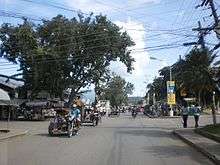
- F. Palmares Sr. Street
- It is also known as the "Calle Real" of Passi since it was the busiest business hub of the city until now. This street is an old national highway when going to the Province of Capiz or Aklan. At present, it is used as an alternative national road going to Iloilo Airport.
- The New City Hall of Passi City
- Built in 1995 as a new municipal hall, but in 1998, it is redesigned to become the new city hall. It is located at Corner Monfort Avenue-Casamayor Street.
- The Old Municipal Hall
- The municipal hall was built in 1930 and it is one of the only surviving Pre-war infrastructures in Passi. Presently, it houses the office of the Department of Agrarian Reform (DAR), Commission on Elections (COMELEC), Post Office, and Conference Hall. The old municipal hall is sometimes known as "Residencia Passi".
- St. William The Hermit Parish Church Convent
- The largest and tallest parish convent in the whole Archdiocese has two reception halls (Jubilee Hall and Lamunan Hall) that can be used in various occasions such as wedding reception.
- Plaza Paloma
- Located just in front of the old municipal hall. The large pineapple restroom is one of the most attractive feature of the said park. The park also has a multipurpose sporting court for the people who want to do recreational activities such as playing badminton, tennis and others.
- Paseo de Passi
- Just few meters away from plaza paloma, is a brick floored paseo that is a perfect place for people who are fond of doing fitness exercises.
- Passi City Public Market
- The new public market of Passi is the largest in the whole Iloilo Province.
- Old Jalaur Railway Bridge
- Also known as Watanabe Terror Bridge, it is one of the fewest railroad bridges left in the whole Panay. It is one of the major landmarks of Passi that needs further preservation.
- Muscovado Chimney
- The muscovado chimney of Passi Sugar Central is the largest and tallest in the whole Panay island.
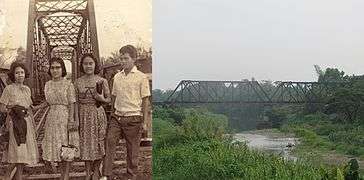 Jalaur Railway Bridge (left: circa 1955, right: present)
Jalaur Railway Bridge (left: circa 1955, right: present)- Jalaur Railway Bridge, also known as Watanabe Terror Bridge
 Col. Alberto Perlas Monument at Plaza Paloma
Col. Alberto Perlas Monument at Plaza Paloma Plaza Paloma Pineapple Restroom and Mini Lagoon
Plaza Paloma Pineapple Restroom and Mini Lagoon Old Municipal Hall
Old Municipal Hall Passi City Public Market
Passi City Public Market St. William The Hermit Parish Church Convent
St. William The Hermit Parish Church Convent- Muscovado Chimney at Hacienda Dulalia, Brgy. Imbang Grande
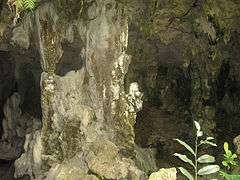 Bitas Cave
Bitas Cave Tinay Cave
Tinay Cave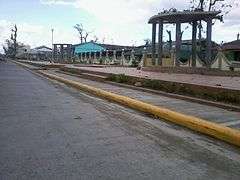 Paseo de Passi
Paseo de Passi
Travel and Leisure
The city has an abundance of inland resorts, hotels, and restaurants to cater the needs of the tourists as well as the residents themselves. The past decade saw an influx of inland resorts, which became a hit among Passinhon tourists. The inland resorts in the city are in northern part of Passi such as Kawilihan Family Resort at Brgy. Bacuranan and Spring Garden Therapeutic Family Resort at Barangay Sablogon . For free means of leisure and entertainment, residents go to Plaza Paloma, which is centrally located at the heart of the city where nearby establishments such as Jollibee Passi and Gaisano Capital Passi are just walking distance away.
Restaurants are also present in the city. Among the famous dining destinations is Midway. Located along IBRD Expressway, Brgy. Bacuranan, anyone can have a stopover and take a breathtaking dinner, along with a deep relaxation with nature. Biscafe (beside Gaisano Capital Passi) takes tourist to a whole new level by offering exotic coffees and massive-sized burgers. Anyone who crave for restaurant-style dishes may opt for Tres Hijos Restaurant (Simeon Aguilar St.)and MVP Bar and Grill (Saligumba St.). Meat lovers may go to Teredol Steak House, and for Filipino dish lovers, may go to Kusina sa Highway. Both of which are located along Simeon Aguilar St. Aside from these, many other restaurants are here to offer delicious food for everyone.
Passi doesn't stop only to restaurants. There are variety of hotels ready to offer good night sleep for everybody. Among the hotels are Garden Pavilion Hotel, Auser Drive-Inn Pension House, and Pintados Pension House.
Health and Social Services
The City of Passi in its goal to have a healthy environment and thereby realized a healthy community has intensified its health and social programs and activities. Consequently, it has improved the health situation and public services of the entire populace through government services and non-government organizations. Don Valerio Palmares Sr. Memorial District Hospital is the only medical center in downtown Passi. There are other health institutions such as Medicus Passi and Fronthub Medilab and Clinics which also offer high quality health services.
In October, 2013, the inauguration of the extension hospital in Brgy. Salngan took place. The hospital will help residents who live very far away from the city proper in giving necessary medical attentions and first aid.
Chameleon Association, Inc.
Founded in 1997 by French national Laurence Ligier, Chameleon Association, Inc (CAI), is a non- stock, non-profit and non-government organization that provides holistic and comprehensive rehabilitation to girls survivors of sexual abuse in Western Visayas. Likewise, CAI provides educational assistance to underprivileged but deserving children in our neighboring communities in Passi, San Enrique and Bingawan through its Sponsorship Program. The said organization is located in Brgy. Sablogon, Passi City.
The Chameleon Association has branches in Paris, Luxembourg, and Switzerland and contacts in Belgium and Andorra.
Chameleon aims to give children and their families access to education and training; and support medically, morally, legally, and financially so as to help them have honorable and successful living conditions in the long-term. The association has also put in place a prevention program for the protection and training to reintegrate these children back into society and give them an everlasting survival strategy.
The Chameleon Association has an integrated approach and multiple programs to support and protect the children from the region. Their rehabilitation program handles young girls who are victims of sexual abuse in two stages: a three-year residential program and a post-residential program for rehabilitation. The community development program supports the studies of children who are victims of great poverty. This organization has also implemented programs for health, the defense of Children’s rights, and income-generating projects.
The Chameleon Association creates long lasting relationships between the children and their sponsors through the exchange of letters, drawings, photographs, report cards, and small gifts.
Chameleon gives back to these children part of their innocence and helps them to fulfill their dreams of going to school and having a future.
Sports
Passi has one of the finest athletic field in the province before. The hilly back portion of Passi National High School was bulldozed by Mayor Palmares, leveled, improved, and beautified in time for the most lavished Unit Athletic Meet ever held in the interior in 1949-1959. Passi also holds the record for having the First Provincial Athletic Meet in the interior before the war.
Due to the closure of the Passi National High School Athletic Field, Passi is rarely hosting sporting events. The last athletic event held was the Congressional Meet last 2011, and Passi finally hosted again such huge sporting affair for fourteen years. In order for the city to regain its lost prestige in sports, a plan regarding the construction of the Passi City Sports Complex was officially announced. The city government aimed to make Passi City the host in the future's congressional, provincial, and even regional athletic events. The said infrastructure is said to be constructed beside Passi City College at Brgy. Bacuranan. No exact starting date of construction was announced.
Transportation
The city can be reached by bus, although some people can take it by taxi from Iloilo City. Tricycle and jeepney are the major means of transportation within Passi.
From Manila, one can take direct flights of Philippine Airlines, Cebu Pacific, Airphil Express or Zest Air to Iloilo. Flying time approximately takes 45 minutes. From Cebu, Iloilo is even nearer—a mere 30 minutes away. One can also take the longer but infinitely more exciting ferry trips from the North Harbor aboard the ships of WG&A, Negros Navigation, and Sulpicio Lines. A ferry trip to Iloilo City usually takes 24 hours. From the Iloilo Airport or Iloilo Seaport, one can take a cab to the bus terminal located at Brgy. Tagbak, Iloilo City and get on a bus (CIBLA or Ceres) to Passi City. The trip usually takes 45 minutes before one reaches Passi City Bus Terminal, which is 42 kilometers from Iloilo City. Passi City can also be reached from Manila for 18 hours or more via IBRD Expressway on a RORO Bus (Philtranco, Ceres, Dimple Star, Alps or Valisno).

- Train (defunct)
- Before the popularity of buses, taxis, jeepneys, and other motorized vehicles, and the construction of the IBRD Expressway from Iloilo City to Roxas City, Capiz; Passi can be reached through steam-operated train. Passi, the midpoint of the railway line between Iloilo and Capiz, is the central terminal of the Panay Railways, Inc. The popularity of motorized vehicles and better road networks caused the railway transportation to become defunct, and steam trains were gradually phased out during the 1990s. Continuous plans and efforts are currently undertaken to rehabilitate the defunct Panay Railways system from Iloilo to Capiz.
- Bus
- Passi City can be reached by riding a Ceres Bus (either a regular one or air-conditioned) with destination labels such as Kalibo, Roxas, Caticlan, Tapaz, Jamindan, or San Enrique when riding from Iloilo City. These busses usually take a stopover at the Bus Terminal Complex. CIBLA (Central Iloilo Bus Line Association) Busses are also available, and usually their destination labels are Passi (except with MODESTA wherein their destination from Iloilo is Calinog). Although some bus units from CIBLA and MODESTA are starting to be phased out, a number of regular buses from Ceres with destination labels such as Passi, Calinog via Passi Dueñas and Passi via Dueñas are growing.
- Taxi
- Taxis travelling around Iloilo City can be used in reaching Passi City.

- Jeepney
- Neighboring towns such as Calinog and San Rafael can take a jeepney ride to reach Passi. Several barangays in Passi City make use of jeepney as their mode of transportation.
- Tricycle
- The towns of San Enrique and Dueñas usually make use of tricycle in travelling to Passi. A typical city proper tricycle has an open front, four seaters, back passengers facing backwards and the front ones faces in front. There are also tricycles that are equipped with sound system with portable MP3 players, sidecars with stylish sports-car-looking side wheels, neon lights, automobile-like headlamps on the sidecar, and other various accessories. A very few of these tricycles have even laptop computers on it (as shown during the 2010 Pintados de Pasi Car, Motorbike and Tricycle Show at Passi City Social Hall). Most barangays of Passi take a ride in tricycle when travelling to and from the city proper. Color codes are assigned from each barangay tricycles for easier familiarity.
Local Government

Mayor: Jesry T. Palmares
Vice Mayor: Bonifacio Barbero
Congressman: Hernan Biron, Jr.
City Councilors
- Melinda Chavez
- Horace Panes
- Jovi "Bitoy" Palmares
- Jayson Padilla
- Baltazar "Kap Basan" Panizales
- Cenonito "Nitoy" Pama
- Cornelio "Motsoy" Teves
- Nefisa "Nefie" Paspe-Pantin
- Jun Jun Sumagpao
Ex-officio Councilors:
- Paula Gene Palma(SK President)
- Cornelio Teves (ABC President)
Notable People
- Col. Alberto Perlas - His contribution during the second world war made him become the local hero of Passi. A street along the riverside (Alberto Perlas St.) and a monument in front of Plaza Paloma is dedicated to his heroism.
- Alexander Pama - Flag Officer in Command, Philippine Navy
- Jose S. Palma - The present Archbishop of Cebu and President of Catholic Bishops' Conference of the Philippines
- Ransam S. Pirote - He was awarded as Bagong Bayani by Bagong Bayani Foundation, POEA, DOLE at Heroes Hall, Malacanang, Manila on June 2003.
References
- ↑ "Cities". Quezon City, Philippines: Department of the Interior and Local Government. Retrieved 25 February 2013.
- 1 2 3 4 "Province: Iloilo". PSGC Interactive. Makati City, Philippines: National Statistical Coordination Board. Retrieved 25 February 2013.
- 1 2 3 4 "Total Population by Province, City, Municipality and Barangay: as of May 1, 2010" (PDF). 2010 Census of Population and Housing. National Statistics Office. Retrieved 20 February 2013.
- ↑ "An Act Converting the Sitio of Agtabo in the Barrio of Salngan, Municipality of Passi, Province of Iloilo, into a Barrio of Said Municipality". LawPH.com. Retrieved 2011-04-12.
- ↑ "An Act Changing the Name of the Barrio of Santa Rosa, Municipality of Passi, Province of Iloilo, to Santo Tomas". LawPH.com. Retrieved 2011-04-12.
- ↑ "Province of Iloilo". Municipality Population Data. LWUA Research Division. Retrieved 14 August 2013.
External links
| Wikimedia Commons has media related to Passi, Iloilo. |
- Philippine Standard Geographic Code
- Philippine Census Information
- Local Governance Performance Management System
 |
Dumarao, Capiz |  | ||
| Bingawan Calinog |
|
San Rafael | ||
| ||||
| | ||||
| Dueñas | San Enrique |
